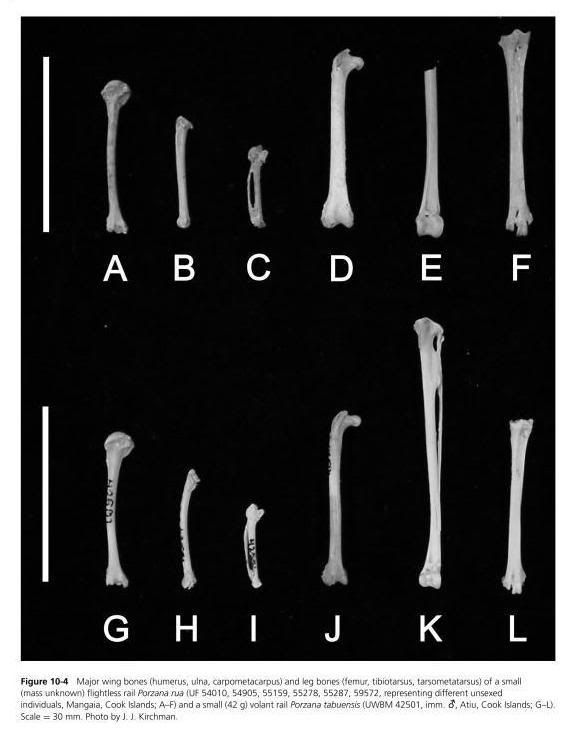|
|
Post by another specialist on Jun 6, 2005 5:49:17 GMT
Porzana rua
Steadman 1986
Holocene of Mangaia, s Cook Islands, sc Pacific Ocean
Primary materials: Holotype: complete humerus, tarsometatarsi
Secondary materials: Paratypes: ulnae, tibiotarsi, tarsometatarsi, humerus, femur
David W. Steadman,
Two new species of rails (Aves: Rallidae) from Mangaia, southern Cook Islands
Pacific Science 40 (1986): 38-54
|
|
|
|
Post by sebbe67 on Oct 30, 2005 18:26:48 GMT
COMMON NAMES: Mangaia Crake
GLOBAL DISTRIBUTION: NATIVE formerly Cooks (extinct)
COOK ISLANDS STATUS: Native, Resident Breeder, Endemic of Cook Islands, Extinct; S.Group - formerly on MG; Land
Vouchers:
Mangaia: recorded in the oldest archaeological layer of 1000AD (J) and not recorded after 1400AD (H), Steadman & Kirch (1990) as Porzana rua.
|
|
|
|
Post by another specialist on Oct 31, 2005 8:44:11 GMT
|
|
|
|
Post by another specialist on Oct 31, 2005 8:44:47 GMT
|
|
|
|
Post by another specialist on Oct 31, 2005 8:46:27 GMT
|
|
|
|
Post by another specialist on Aug 6, 2007 7:53:26 GMT
|
|
|
|
Post by another specialist on Sept 7, 2008 10:53:47 GMT
 Extinction and Biogeography of Tropical Pacific Birds By David W. Steadman |
|
|
|
Post by adzebill on Jan 9, 2011 19:29:15 GMT
David W. Steadman, Two new species of rails (Aves: Rallidae) from Mangaia, southern Cook Islands Pacific Science 40 (1986): 38-54 Full text article here: scholarspace.manoa.hawaii.edu/bitstream/10125/1002/1/v40-27-43.pdf There is something intringuing data cited on the article: "Only one of the three species of rails known from Mangaia survives there today, and this very likely is Porzana tabuensis, although no modern specimens exist to document its occurrence. According to the Mangaians, a small, black rail exists on their island. This elusive bird is known as the "mo'o mo'o." Many Mangaians told me ofseeing or hearing the "mo'o mo'o " on rare occasions in the taro swamps on the inner side of the makatea. These persons generally said that the bird has become rarer during their own lifetimes. As noted in Steadman (1985), the capture of a modern specimen of"mo'o mo'o" is a goal of future fieldwork on Mangaia. It would seem at first that the "mo' o mo'o" will prove to be P. tabuensis, particularly because some Mangaians claim that it can fly, although weakly and not for long distances, and because one would presume that a volant or bare ly volant species would persist longer than a flightless species such as Porzana rua. Nevertheless, when confronted with Plate 9 of duPont (1976), in which both P. tabuensis and P. atra are illustrated in color, the Mangaians invariably pointed to P. atra as being their "mo' o mo'o ," noting the totally black body and the bright red iris and tarsus. Until a specimen is procured, it is uncertain whether Mangaia's rare but surviving "mo'o mo'o" might be P. rua rather than P. tabuensis." |
|